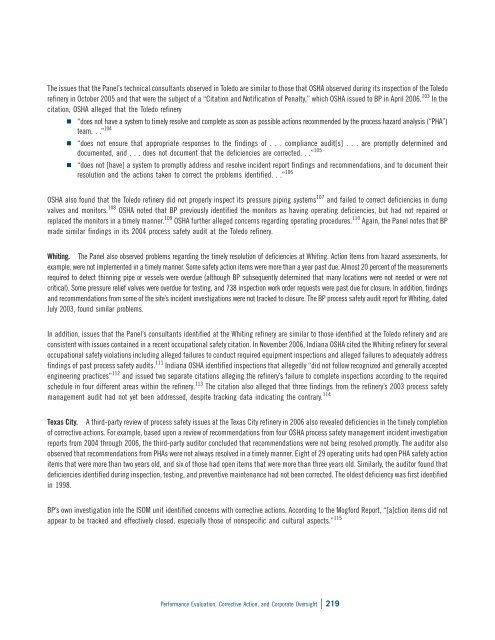The Baker Panel Report - ABSA
The Baker Panel Report - ABSA
The Baker Panel Report - ABSA
Create successful ePaper yourself
Turn your PDF publications into a flip-book with our unique Google optimized e-Paper software.
<strong>The</strong> issues that the <strong>Panel</strong>’s technical consultants observed in Toledo are similar to those that OSHA observed during its inspection of the Toledorefinery in October 2005 and that were the subject of a “Citation and Notification of Penalty,” which OSHA issued to BP in April 2006. 103 In thecitation, OSHA alleged that the Toledo refinery “does not have a system to timely resolve and complete as soon as possible actions recommended by the process hazard analysis (“PHA”)team. . .” 104 “does not ensure that appropriate responses to the findings of . . . compliance audit[s] . . . are promptly determined anddocumented, and . . . does not document that the deficiencies are corrected. . .” 105 “does not [have] a system to promptly address and resolve incident report findings and recommendations, and to document theirresolution and the actions taken to correct the problems identified. . .” 106OSHA also found that the Toledo refinery did not properly inspect its pressure piping systems 107 and failed to correct deficiencies in dumpvalves and monitors. 108 OSHA noted that BP previously identified the monitors as having operating deficiencies, but had not repaired orreplaced the monitors in a timely manner. 109 OSHA further alleged concerns regarding operating procedures. 110 Again, the <strong>Panel</strong> notes that BPmade similar findings in its 2004 process safety audit at the Toledo refinery.Whiting. <strong>The</strong> <strong>Panel</strong> also observed problems regarding the timely resolution of deficiencies at Whiting. Action items from hazard assessments, forexample, were not implemented in a timely manner. Some safety action items were more than a year past due. Almost 20 percent of the measurementsrequired to detect thinning pipe or vessels were overdue (although BP subsequently determined that many locations were not needed or were notcritical). Some pressure relief valves were overdue for testing, and 738 inspection work order requests were past due for closure. In addition, findingsand recommendations from some of the site’s incident investigations were not tracked to closure. <strong>The</strong> BP process safety audit report for Whiting, datedJuly 2003, found similar problems.In addition, issues that the <strong>Panel</strong>’s consultants identified at the Whiting refinery are similar to those identified at the Toledo refinery and areconsistent with issues contained in a recent occupational safety citation. In November 2006, Indiana OSHA cited the Whiting refinery for severaloccupational safety violations including alleged failures to conduct required equipment inspections and alleged failures to adequately addressfindings of past process safety audits. 111 Indiana OSHA identified inspections that allegedly “did not follow recognized and generally acceptedengineering practices” 112 and issued two separate citations alleging the refinery’s failure to complete inspections according to the requiredschedule in four different areas within the refinery. 113 <strong>The</strong> citation also alleged that three findings from the refinery’s 2003 process safetymanagement audit had not yet been addressed, despite tracking data indicating the contrary. 114Texas City. A third-party review of process safety issues at the Texas City refinery in 2006 also revealed deficiencies in the timely completionof corrective actions. For example, based upon a review of recommendations from four OSHA process safety management incident investigationreports from 2004 through 2006, the third-party auditor concluded that recommendations were not being resolved promptly. <strong>The</strong> auditor alsoobserved that recommendations from PHAs were not always resolved in a timely manner. Eight of 29 operating units had open PHA safety actionitems that were more than two years old, and six of those had open items that were more than three years old. Similarly, the auditor found thatdeficiencies identified during inspection, testing, and preventive maintenance had not been corrected. <strong>The</strong> oldest deficiency was first identifiedin 1998.BP’s own investigation into the ISOM unit identified concerns with corrective actions. According to the Mogford <strong>Report</strong>, “[a]ction items did notappear to be tracked and effectively closed, especially those of nonspecific and cultural aspects.” 115Performance Evaluation, Corrective Action, and Corporate Oversight C 219

















